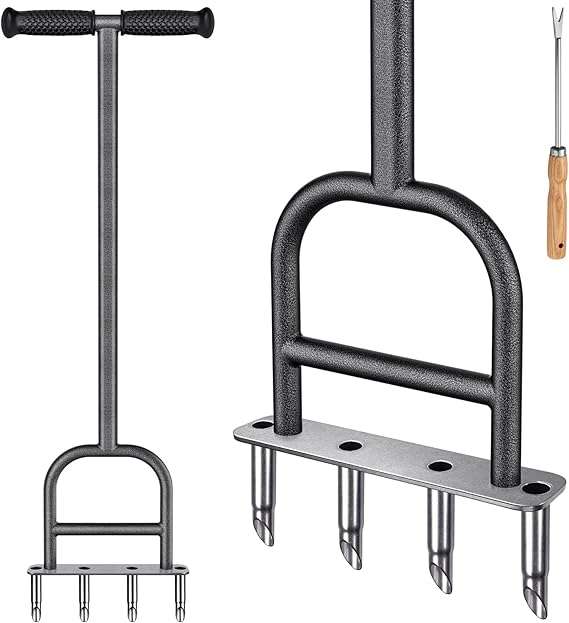Bermuda grass is a robust and popular choice for lawns, known for its vibrant green color and dense growth. However, even the healthiest Bermuda grass lawns can benefit from aeration. Aeration improves soil health, enhances nutrient absorption, and allows your grass to thrive.
In this blog post, we’ll explore the ins and outs of aerating Bermuda grass, why it’s essential, and how to do it effectively.
What Is Lawn Aeration?
Lawn aeration is the process of perforating the soil with small holes to improve air, water, and nutrient penetration. For Bermuda grass, aeration is particularly beneficial because it often grows in compacted soils, which can restrict root development and overall growth.
Benefits of Aerating Bermuda Grass
- Enhanced Root Growth
Aeration allows roots to grow deeper by breaking up compacted soil, leading to a more resilient and drought-tolerant lawn. - Improved Nutrient Uptake
Aeration creates channels for fertilizers and nutrients to reach the root zone, ensuring efficient feeding. - Better Water Absorption
Aeration prevents water runoff by improving soil drainage, allowing water to penetrate deeply into the soil. - Reduction in Thatch Buildup
Aeration helps decompose thatch—a layer of dead grass and organic material that can choke your lawn if left unchecked. - Improved Air Exchange
Aeration increases oxygen flow to the roots, which is essential for healthy grass growth.
When to Aerate Bermuda Grass
Timing is critical when aerating Bermuda grass. It’s best to aerate during its active growing season, which is late spring to early summer. Here’s why:
- Optimal Growth: Bermuda grass is most resilient during its growing season, allowing it to recover quickly from aeration.
- Soil Temperature: Warm soil promotes faster healing and root expansion.
- Reduced Stress: Aerating during dormancy can stress the grass and lead to poor results.
Signs That Your Bermuda Grass Needs Aeration
- Compacted Soil: If your soil feels hard and dense, it’s likely compacted and in need of aeration.
- Puddling Water: Poor water absorption or pooling after rainfall indicates soil compaction.
- Thin or Patchy Grass: Compacted soil restricts root growth, leading to thinning or bare spots.
- Excessive Thatch: A thick thatch layer can prevent air, water, and nutrients from reaching the roots.
How to Aerate Bermuda Grass
- Choose the Right Equipment
- Core Aerators: Remove small plugs of soil for deep aeration. Ideal for compacted soils.
- Spike Aerators: Create holes by poking the soil. Suitable for less compacted areas but less effective than core aerators.
- Prepare the Lawn
- Water: Water the lawn thoroughly 24-48 hours before aeration. Soft soil is easier to penetrate.
- Mow: Cut the grass to its regular height to prevent interference with the aerator.
- Aerate in Multiple Directions
- Run the aerator in one direction, then repeat perpendicular to the first pass. This ensures even coverage.
- Leave Soil Plugs on the Lawn
- The plugs decompose naturally, returning nutrients and organic matter to the soil.
- Fertilize and Water
- Apply fertilizer immediately after aeration to deliver nutrients directly to the roots.
- Water the lawn lightly to encourage recovery and promote new growth.

Lawn Coring Aerator, Stainless Steel 4 Corer Plug Aerator Tool with Soft Rubber Grip
Enjoy the durability and strength of this lawn coring aerator, which is made of all steel with a black powder coated finish, It with stainless steel bottom and corer plug that will not rust or bend.
Best Practices for Bermuda Grass Aeration
- Frequency: Aerate once a year, or twice annually for heavily compacted soils or high-traffic lawns.
- Soil Testing: Conduct a soil test before aerating to identify additional issues like pH imbalance or nutrient deficiencies.
- Follow with Overseeding: After aeration, overseed any bare spots for a fuller, healthier lawn.
- Pair with Dethatching: If your lawn has excessive thatch, dethatch before aerating to maximize the benefits.
Common Mistakes to Avoid
- Aerating During Dormancy
- Aerating when Bermuda grass is dormant can stress the lawn and delay recovery.
- Skipping Watering
- Dry soil is difficult to aerate and can damage the equipment.
- Using the Wrong Aerator
- Choose a core aerator for compacted soil rather than a spike aerator, which may worsen compaction.
- Over-Aerating
- Aerating too frequently can damage the soil structure and stress the grass.
FAQs About Bermuda Grass Aeration
1. How long does it take for Bermuda grass to recover from aeration?
Recovery typically takes 7-10 days during the growing season, provided the lawn is properly watered and fertilized.
2. Can I aerate Bermuda grass manually?
Yes, handheld aerators or aeration shoes can be used for small lawns, but they are labor-intensive and less effective than powered equipment.
3. Is it necessary to aerate sandy soils?
While sandy soils are less prone to compaction, occasional aeration can still be beneficial, especially in high-traffic areas.
Conclusion
Aeration is a vital practice for maintaining a healthy, vibrant Bermuda grass lawn. By improving soil structure, enhancing nutrient absorption, and promoting robust root growth, aeration ensures your lawn remains lush and resilient. Whether you’re dealing with compacted soil or looking to give your grass a growth boost, incorporating aeration into your lawn care routine can make a significant difference.
Ready to revitalize your Bermuda grass? Start aerating today and enjoy the benefits of a healthier, greener lawn!